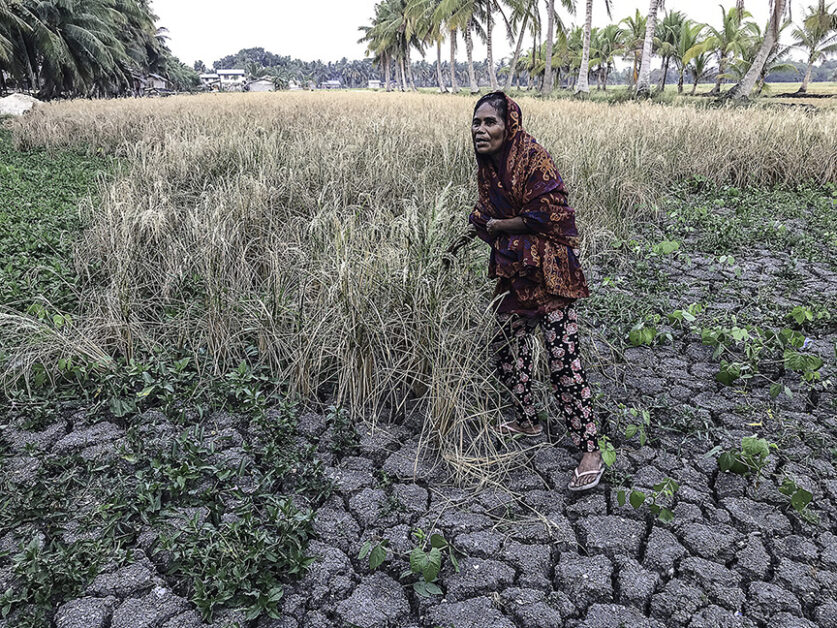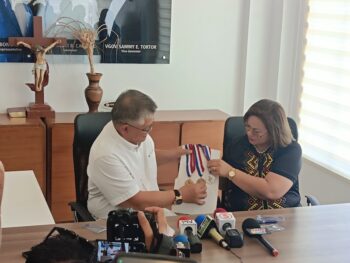 File photo of a farm affected by drought in Datu Saudi Ampatuan in the then undivided Maguindanao province. MindaNews file photo by FERDINANDH CABRERA
File photo of a farm affected by drought in Datu Saudi Ampatuan in the then undivided Maguindanao province. MindaNews file photo by FERDINANDH CABRERA
KORONADAL CITY (MindaNews / 24 April) – Officials have placed Maguindanao del Sur in the Bangsamoro region under a state of calamity due to the effects of the El Nino phenomenon, which destroyed crops and livestock worth nearly P346 million over the past weeks.
Governor Mariam Sangki-Mangudadatu approved Resolution 039 passed by the provincial legislative board, declaring a state of calamity in the entire province.
In a statement on Tuesday, Mangudadatu said 20 of the 24 towns in her province have been severely affected by the prolonged dry spell and dwindling water sources.
Nearly 6,000 farmers lost livelihood opportunities due to the prevailing extremely hot weather, she said.
Mangudadatu blamed the intense weather conditions for the heavy toll on corn and rice farms, banana plantations, livestock and poultry.
“The supply of fresh water fish was also affected,” the governor added.
Maguindanao del Sur is the second province in the Bangsamoro Autonomous Region in Muslim Mindanao (BARMM) to declare a state of calamity because of the drought triggered by El Niño.
On April 17, the provincial board of Basilan passed Resolution No. 01-2024, declaring the entire island-province under a state of calamity following losses in agriculture amounting to P315 million.
Basilan Governor Hadjiman Salliman said many people in Basilan rely mainly on agriculture for their source of income.
In Datu Odin Sinsuat town in Maguindanao del Norte, local legislators declared the town in a state of calamity, through Resolution No. 2024-01 that was approved by Mayor Lester Sinsuat on Tuesday, April 23.
The town’s Disaster Risk Reduction and Management Council reported that the long dry spell has affected 17,548 households in the town while 2,039 farmers lost their livelihood.
At least 1,370 hectares of farm lands – “40% rice farms, 40% corn farms and 20% high value crop farms are affected,” the report said.
An official of the Ministry of Agriculture, Fisheries and Agrarian Reform (MAFAR) in the BARMM said initial reports they received show that at least 26,000 farmers in the region were affected by the El Niño phenomenon.
Bahrain Piang, head of MAFAR Field Operation Division, said they are currently validating the report using the Registry System for the Basic Sector in Agriculture (RSBSA), a listing of farmers in the region that they use for monitoring and extending assistance.
“We are looking at the possibility that the number of affected farmers will increase,” he said, pointing out that the agency has a ready stock of buffer seeds that will be given to the farmers.
Citing an initial assessment report in early April, Piang said the prolonged dry spell has destroyed 19,731 hectares of corn farms and 5,472 hectares of rice land. The drought also affected 690 hectares of vegetable farms, 45 hectares of fruit trees and 56 hectares of cassava, a known staple in several communities in the region.
The Bangsamoro region’s Disaster Risk Reduction and Management Council has placed BARMM under a “blue alert” status in mid-April, when intense heat conditions were observed to have been affecting farmlands.
A blue alert status sets into motion the region’s action plan on El Nino, said MAFAR Minister Mohammad Yacob, explaining that the alert status activates the Bravo Emergency Preparedness and Response Protocol or the Bangsamoro Action Plan on El Niño.
This protocol requires that all disaster response councils of local government units undertake Rapid Damage Assessment and Needs Analysis in their respective areas, he said. (Rommel Rebollido / MindaNews)
